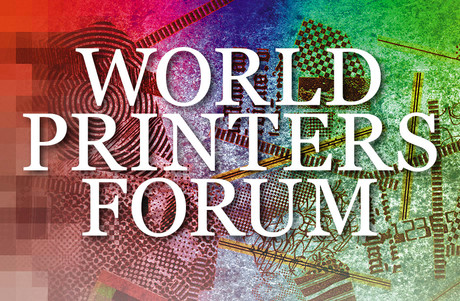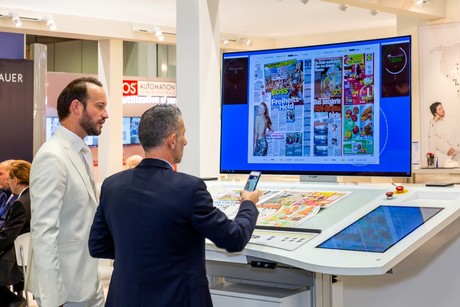Weeke is committed to lean structures and processes plus a high level of automation in newspaper printing. Production takes place in three shifts on a manroland Colorman autoprint Press featuring four four-high towers with a satellite design and two folders. The newspaper web press can be operated either as two 32-page presses or in various other production modes.
Focus on newspapers and freesheets
Publications by the Magdeburg Media Group form the mainstay of the printer’s business. Volksstimme, which is printed at night, appears six times a week in 18 subeditions, totaling more than 170,000 copies. Several weekly freesheets – General-Anzeiger am Mittwoch (12 subeditions, circulation approximately 490,000), General-Anzeiger am Wochenende (15 subeditions, circulation approximately 630,000) and the tabloid Elbe-/Ohre-Kurier (2 subeditions, circulation more than 154,000) are produced during the daytime.
All in all, these products add up to an average consumption of 1500 plates a day. These are imaged at the printing center on two violet CTP systems with online plate processors. The KODAK LIBRA VP Digital Plate was first introduced on these machines in May 2016. This negative-working newspaper printing plate from Kodak has a violet photopolymer coating and was chosen to replace plate types from two other manufacturers. “We started testing the LIBRA VP Plate at the end of 2015. The trial phase was a huge success: the plates gave us clean and crisp dots every time and the results were impressive. We received professional and very reliable support from Kodak’s experts throughout this period as well as afterwards when we changed over completely,” says Michael Nordmann, Technical Director of Magdeburg Media Group.
Maximum automation all the way to the press
The path from platemaking to the printing press some distance away is slightly unorthodox. As soon as the plates have passed through the processors and the punch and bending unit downstream of the CTP imager, a complex, fully automated plate logistics take over. The printing units where the plates are actually needed are the destination. Robot arms execute the plate changes simultaneously in all units. “Our printers never touch the plates any more or subject them to a visual inspection before they’ve been positioned on the plate cylinders. Everything’s automatic, which means our make-ready processes are as streamlined and efficient as possible. That’s an immense advantage because our products have so many different subeditions and frequent plate changes are therefore unavoidable,” Nordmann reports. “From the last good copy of one edition to the first good copy of the next, it takes only eight minutes on average.”
Using a robot to change the plates automatically only works if the plates meet very strict requirements. “Our printing plates and dummy plates have to have a uniform flexural strength and their format must conform to a narrow tolerance of ±0.5 mm in order for the automated logistics to function smoothly,” Nordmann explains. “We can count on that with the LIBRA VP Plate but it was much more difficult with the old plate types.”
The newspaper print service provider uses a conventional method, with prewash as well as downstream rinse and gum steps, to process the KODAK LIBRA VP Plate. This enables the plate to keep going with run lengths of up to 350,000 impressions. The Barleben printer is not quite in that league; the counters on the web press show a maximum of 150,000 prints for individual runs.
Reduced maintenance and less complex plate processing
Filtration systems were used by Weeke on the plate processors prior to migrating to the LIBRA VP Plate to extend the life of the chemistry and achieve longer maintenance cycles. “After switching to Kodak, we discovered that we can work for just as long without filtration as with. Today, we only replace the chemistry after eight weeks, yet the machine is still far cleaner than it was with the old plates; in other words, it now requires less maintenance as a result,” Michael Nordmann adds.
After about twenty months of daily production with the LIBRA VP Plate, Michael Nordmann’s assessment is thoroughly positive: “We have to consider plate usage in an overall context. We need a product that combines reliable print quality with dimensional accuracy and causes as few disruptions as possible throughout the entire production process. Value for money is an important criterion, which the LIBRA VP Plate fulfills absolutely. That’s why we’ve never once regretted the decision to change over to the KODAK plate.”
(http://www.kodak.com)
Kodak Libra VP Plates perfectly made for automated processes in newspaper production
Kodak Libra VP Plates perfectly made for automated processes in newspaper production
Article ID:
21665
The Kodak Libra VP Digital Plate has convinced R. Weeke Betriebs GmbH with its platemaking efficiency, reliable quality and optimal support for fully automated plate logistics
28.02.2018 – R. Weeke Betriebs GmbH of Barleben, near Magdeburg (Germany), focuses exclusively on its core business: printing and finishing of newspapers, advertising supplements and freesheets. Weeke, which employs around 300 people at its Barleben Printing Center, belongs to the Magdeburg Media Group, whose best-known printed product is the daily Volksstimme.

Robot arms execute the plate changes simultaneously in all units of the newspaper press.
Attachments
Related Articles
-
2020-10-15 10:21
-
2020-10-08 09:36
-
2020-09-29 16:42
-
2020-09-29 16:24
-
2020-09-29 09:57




